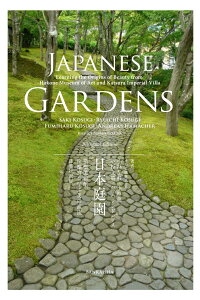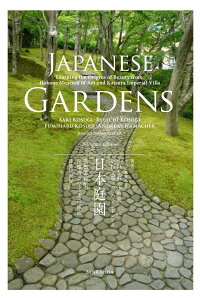小杉左岐、小杉龍一、他 著「JANAPENE GARDENS 日本庭園」万来舎
現在の仕事を始める前の職場の食堂にポスターがあり、本書が案内されていました。全く関係のないメーカーの食堂に、なぜか本書と他の書籍のポスターでした。気になりながら、その職場をさりましたが、海外の方に日本文化を伝える中、日本庭園についても情報が必要となり、本書も購入することになりました。
小杉造園株式会社の方々が執筆されており、日英対訳版です。日本庭園の基礎を知るには、必要な知識が後半にまとめて掲載されています。いずれの文章も英訳されていますので、英語の通訳ガイドの方にとっては、必須英単語も覚えることができて、一石二鳥といえます。
代表的な庭園を、関東、関西で1つずつ取り上げていますから、現地を案内する時の事前学習にも使えます。関東の庭園として箱根美術館の神仙郷、関西の庭園として桂離宮に関して写真を多用しながら詳述されています。
第一章の箱根の庭園を訪問したことがないので、どの程度、参考になるかは承知しませんが、第二章の桂離宮には、訪問したことがありますので、本書の記述は役立つものばかりと実感します。桂離宮のパートでは、橋や飛び石、燈籠、生垣などの紹介だけでなく、遠近法などの庭園に埋め込まれた仕掛けについても説明してくれています。このお値段で内容の豊富さを考えると、かなりお値打ち感のある本だと思います。
最終の第三章は、三要素と添景物と題して、庭の中心となる池泉、庭の骨格をつくる石、四季の風情を際立たせる植栽、庭の風景を引き締める添景物、一期一会を楽しむ茶室・茶庭について解説しています。もちろん、和英併記なので、役立つこと請け合いです。(完)

価格:1,320円
(2021/6/15 14:28時点)
感想(0件)
JANAPENE GARDENS (English)
“JANAPENE GARDENS” by Saki Kosugi, Ryuichi Kosugi, and others, Banraisha
Before I started my current job, there was a poster in the cafeteria of my workplace, announcing this book. For some reason, it was a poster of this book and other books in the cafeteria of a completely unrelated manufacturer. I was curious about the book and left the workplace, but as I was teaching Japanese culture to people overseas, I needed information about Japanese gardens, so I decided to buy this book as well.
It is written by people from Kosugi Landscaping Co., Ltd. and is a Japanese-English bilingual edition. The latter half of the book contains the necessary knowledge to know the basics of Japanese gardens. All the texts are translated into English, so English interpreter guides can learn essential English words. So you can kill two birds with one stone.
The book covers two representative gardens, one in the Kanto region and the other in the Kansai region, which can be used for prior study when guiding visitors. The book includes detailed descriptions of the Hakone Museum’s Shinsen-go garden in the Kanto region and the Katsura Rikyu garden in the Kansai region, with many photographs.
I have not visited the garden in Hakone in the first chapter, so I am not aware of how helpful it would be, but I have visited Katsura Rikyu in the second chapter, so I feel that the descriptions in this book are all useful. The part on Katsura Rikyu not only introduces the bridges, stepping stones, lanterns, and hedges, but also explains the perspective and other tricks embedded in the garden. Considering the richness of the contents at this price, I think this book is quite a good value.
The third and final chapter, titled “The Three Elements and Accompaniments,” describes the pond and fountain at the center of the garden, the stones that form the backbone of the garden, the plantings that accentuate the beauty of the four seasons, the accoutrements that enhance the garden scenery, and the tearoom and tea garden where you can enjoy a once-in-a-lifetime experience. Of course, it is written in both Japanese and English, so you can be sure that it will be useful. (End)
JARDINS DE JANAPENE (Français)
“JANAPENE GARDENS” par Saki Kosugi, Ryuichi Kosugi, et d’autres, Banraisha
Avant que je ne commence mon travail actuel, il y avait une affiche dans la cafétéria de mon lieu de travail, annonçant ce livre. Pour une raison quelconque, il y avait une affiche de ce livre et d’autres livres dans la cafétéria d’un fabricant n’ayant aucun rapport avec le sujet. J’étais curieux à propos de ce livre et j’ai quitté le lieu de travail, mais comme j’enseignais la culture japonaise à des personnes à l’étranger, j’avais besoin d’informations sur les jardins japonais, j’ai donc décidé d’acheter ce livre également.
Il est écrit par des personnes de Kosugi Landscaping Co., Ltd. et est une édition bilingue japonais-anglais. La seconde moitié du livre contient les connaissances nécessaires pour connaître les bases des jardins japonais. Tous les textes sont traduits en anglais, ce qui permet aux guides interprètes anglais d’apprendre les mots anglais essentiels. Vous pouvez donc faire d’une pierre deux coups.
Le livre traite de deux jardins représentatifs, l’un dans la région du Kanto et l’autre dans la région du Kansai, qui peuvent être utilisés comme étude préalable pour guider les visiteurs. Le livre comprend des descriptions détaillées du jardin Shinsen-go du musée de Hakone dans la région du Kanto et du jardin Katsura Rikyu dans la région du Kansai, avec de nombreuses photographies.
Je n’ai pas visité le jardin de Hakone dans le premier chapitre, donc je ne sais pas si cela serait utile, mais j’ai visité Katsura Rikyu dans le deuxième chapitre, donc je pense que les descriptions dans ce livre sont toutes utiles. La partie sur Katsura Rikyu ne présente pas seulement les ponts, les tremplins, les lanternes et les haies, mais explique également la perspective et d’autres astuces intégrées dans le jardin. Compte tenu de la richesse du contenu à ce prix, je pense que ce livre est une valeur sûre.
Le troisième et dernier chapitre, intitulé “Les trois éléments et les accessoires”, décrit l’étang et la fontaine au centre du jardin, les pierres qui forment l’épine dorsale du jardin, les plantations qui accentuent la beauté des quatre saisons, les accessoires qui rehaussent le paysage du jardin, ainsi que le salon de thé où vous pourrez vivre une expérience unique. Bien entendu, il est rédigé en japonais et en anglais, vous pouvez donc être sûr qu’il vous sera utile. (Fin)
